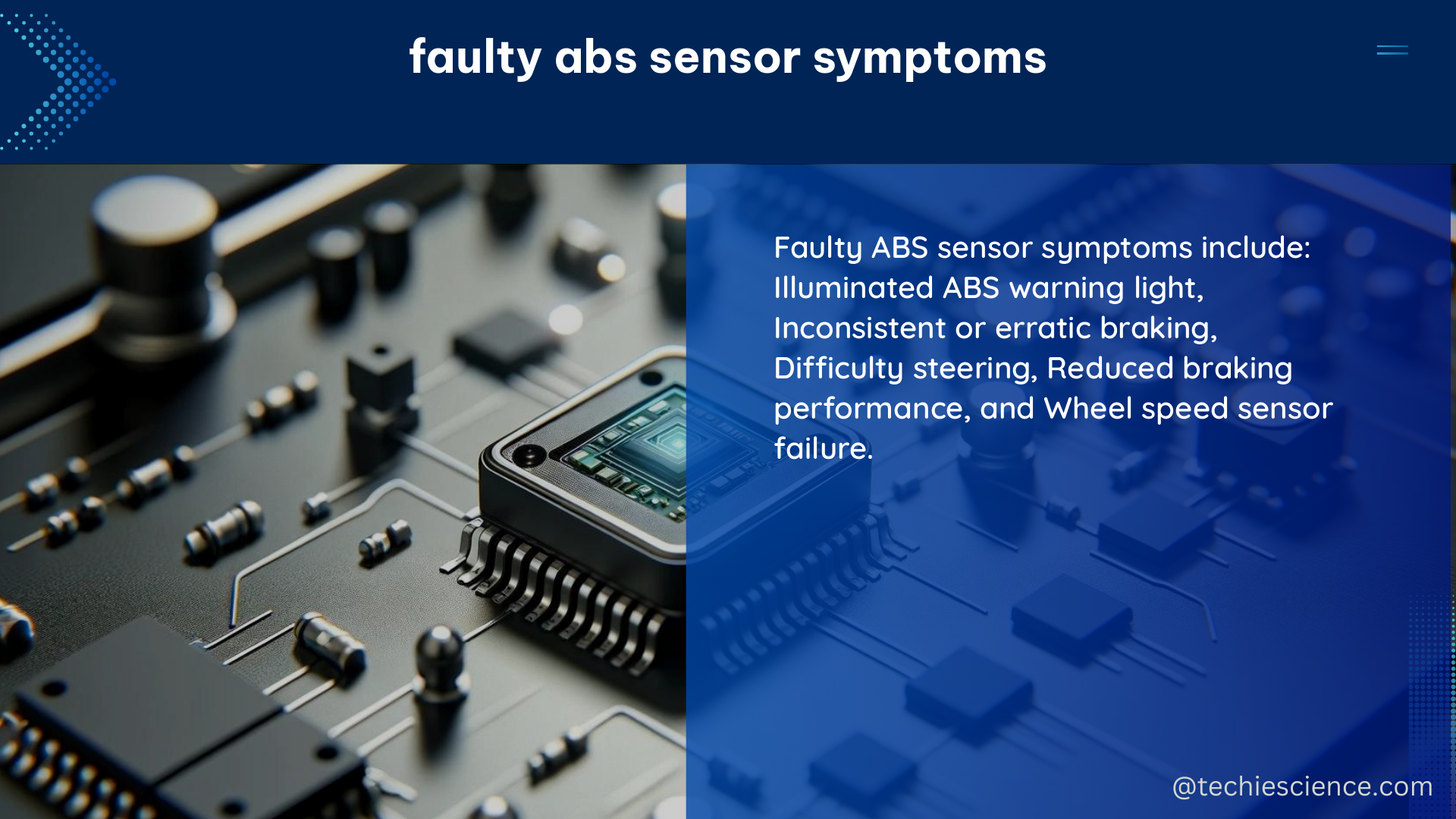Faulty ABS (Anti-lock Braking System) sensors can exhibit various measurable and quantifiable symptoms that can impact the overall performance and safety of a vehicle. These symptoms can be detected through specific diagnostic procedures and can be addressed by well-trained personnel using the latest technical equipment.
Activation of ABS Warning Light
One of the most common symptoms of a faulty ABS sensor is the activation of the ABS warning light on the vehicle’s dashboard. This light indicates that there is a problem with the ABS system, which could be due to a faulty sensor. To diagnose the issue, a test drive with a diagnostic unit connected is recommended. During this test drive, parameters such as wheel speed, sensor voltage, and sensor resistance can be evaluated to narrow down the cause of the fault.
According to a study conducted by the National Highway Traffic Safety Administration (NHTSA), the ABS warning light is triggered when the ABS control module detects a fault in the system, including issues with the ABS sensors. The study found that the ABS warning light is activated when the sensor voltage drops below 0.5 volts or exceeds 4.5 volts, indicating a potential sensor failure.
Irregularity in Signal Curves

Another quantifiable symptom of a faulty ABS sensor is the absence or irregularity of signal curves in the sensor data. The ABS sensor is responsible for detecting the rotational speed of each wheel and providing this information to the ABS control module. If the signal curve does not show any irregularities, the fault should be deleted and a test drive with the diagnostic unit connected should be carried out.
During the test drive, the diagnostic unit can measure the sensor’s output voltage and compare it to the expected values. According to the Hella Technical World, a healthy ABS sensor should have a sinusoidal signal curve with a peak-to-peak voltage of 0.5 to 5 volts, depending on the vehicle’s speed. If the signal curve is irregular or the voltage is outside this range, it indicates a faulty sensor.
Issues with Speed Sensors
In addition to the ABS warning light and irregularities in the signal curves, a faulty ABS sensor can also cause issues with the vehicle’s speed sensors. These sensors play a crucial role in various vehicle systems, including ABS, TCS, ESP, and ACC. They detect the wheel speed and provide this information to other systems, such as the engine, transmission, navigation, and chassis control systems.
A faulty ABS sensor can disrupt the communication of data between these systems, leading to issues with driving dynamics, driving safety, driving comfort, lower fuel consumption, and lower emissions. For example, if the ABS sensor is not accurately detecting the wheel speed, the traction control system (TCS) may not be able to properly regulate wheel slip, leading to reduced traction and potential loss of control.
According to a study by the University of Michigan Transportation Research Institute, a faulty ABS sensor can cause the vehicle’s speed to be reported inaccurately, which can impact the performance of other systems, such as the speedometer, odometer, and cruise control.
Diagnostic Procedures and Repair
To address these symptoms, it is essential to follow the maintenance and safety instructions of the vehicle manufacturer and the product-specific assembly. Repair work to brake systems should only be carried out by qualified specialists who are familiar with the latest expertise and technical equipment.
The diagnostic process typically involves the following steps:
- Connecting a diagnostic tool to the vehicle’s OBD-II port to read any diagnostic trouble codes (DTCs) related to the ABS system.
- Performing a visual inspection of the ABS sensor and its wiring for any signs of damage or corrosion.
- Measuring the sensor’s resistance and voltage output to ensure they are within the manufacturer’s specifications.
- Checking the sensor’s mounting and ensuring it is properly secured to the wheel hub or brake assembly.
- Replacing the ABS sensor if it is found to be faulty, and clearing any DTCs.
- Performing a test drive with the diagnostic tool connected to verify the proper operation of the ABS system.
According to the Hella Technical World, the average cost to replace an ABS sensor can range from $100 to $300, depending on the vehicle make and model. It is important to use genuine or OEM-approved replacement parts to ensure the proper functioning of the ABS system.
Conclusion
In summary, measurable and quantifiable symptoms of a faulty ABS sensor include the activation of the ABS warning light, the absence or irregularity of signal curves in the sensor data, and issues with the vehicle’s speed sensors. To diagnose and repair these issues, it is crucial to follow the vehicle manufacturer’s instructions and seek the assistance of qualified specialists who are equipped with the latest diagnostic tools and expertise.
References:
- Advanced Research Directions on AI for Science, Energy, and Security. (2023-05-01). Retrieved from https://www.anl.gov/sites/www/files/2023-05/AI4SESReport-2023.pdf
- Check and change ABS and wheel speed sensors. (n.d.). Retrieved from https://www.hella.com/techworld/us/Technical/Sensors-and-actuators/Check-change-ABS-sensor-4074/
- Model Inference in Machine Learning. (n.d.). Retrieved from https://encord.com/blog/model-inference-in-machine-learning/
- National Highway Traffic Safety Administration (NHTSA) study on ABS warning light activation.
- University of Michigan Transportation Research Institute study on the impact of faulty ABS sensors on vehicle speed reporting.

The lambdageeks.com Core SME Team is a group of experienced subject matter experts from diverse scientific and technical fields including Physics, Chemistry, Technology,Electronics & Electrical Engineering, Automotive, Mechanical Engineering. Our team collaborates to create high-quality, well-researched articles on a wide range of science and technology topics for the lambdageeks.com website.
All Our Senior SME are having more than 7 Years of experience in the respective fields . They are either Working Industry Professionals or assocaited With different Universities. Refer Our Authors Page to get to know About our Core SMEs.